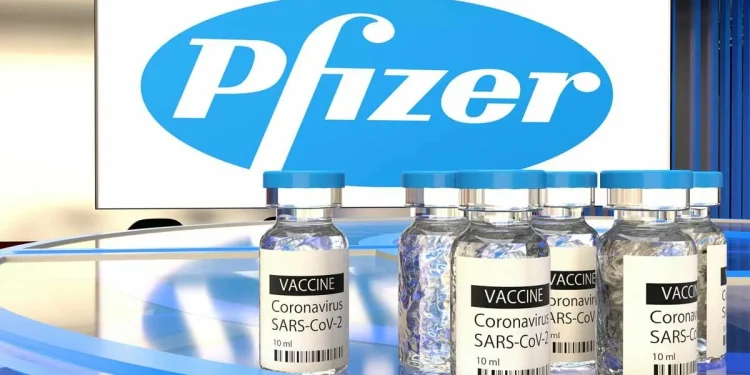
In an era where the world grapples with unprecedented challenges related to public health, a remarkable development has sparked renewed enthusiasm among communities. The introduction of key health solutions has paved the way for a collective response to the ongoing health crisis, instilling a sense of relief and anticipation across various regions.
The recent shipment of critical biomedical supplies represents a vital step toward safeguarding the wellbeing of countless individuals. As nations unite to combat the detrimental effects of a widespread illness, this initiative reflects both resilience and collaboration on a global scale.
This initiative, supported by various stakeholders, highlights the significance of scientific innovation and strategic partnerships. As authorities work tirelessly to ensure the welfare of their populations, the momentum generated through such endeavors inspires optimism and sets the stage for a brighter future.
Amidst the challenges faced, the successful implementation of these healthcare measures underscores humanity’s unwavering commitment to overcoming adversity. This pivotal moment serves as a reminder of the power of unity and the importance of remaining steadfast in the pursuit of welfare for all.
Significance of Vaccine Delivery Today
The distribution of immunization products holds immense importance in the context of public health. It symbolizes progress, a collaborative effort among various entities, and a step towards protecting communities from infectious diseases. The successful transportation of these health solutions not only addresses immediate needs but also instills confidence in the global health infrastructure.
The Impact on Public Health
-
Enhancement of herd immunity, leading to a reduction in transmission rates.
-
Immediate protection for vulnerable populations, such as the elderly and those with pre-existing conditions.
-
Support for healthcare systems by decreasing hospitalizations and severe cases.
Global Responses and Collaboration
-
Demonstrates international solidarity and cooperation in overcoming health challenges.
-
Encourages investment in research and development for future health crises.
-
Fosters trust between citizens and health authorities, promoting public health initiatives.
The successful transfer of these health assets is not merely a logistical achievement; it reflects a unified approach to safeguarding the population and nurturing a resilient society.
Government Response to Vaccine Arrival
The arrival of critical biomedical supplies has prompted a swift and strategic reaction from the authorities. The significance of these advancements cannot be overstated, as they represent a turning point in the battle against widespread health crises. Officials are keen to manage distribution effectively, ensuring that all areas gain access without delay.
In response, the government has outlined several key initiatives:
-
Strategic Distribution Plan: A comprehensive framework to facilitate the efficient allocation of medical supplies across regions.
-
Public Awareness Campaign: Efforts to educate the populace about the importance of immunization and the safety protocols in place.
-
Collaboration with Health Institutions: Partnerships with various healthcare organizations to streamline administration and monitor progress.
-
Emergency Response Teams: Mobilization of specialized units to oversee the distribution process and address any logistical challenges.
Furthermore, local leaders have been encouraged to engage communities and address concerns, fostering trust and transparency. The overarching goal remains clear: to safeguard public health and pave the way for a swift recovery.
By addressing these challenges head-on, the government aims to build a robust framework that not only responds to the immediate needs but also ensures long-term resilience against future health threats.
Public Reactions and Expectations
The arrival of significant health supplies has sparked a wave of enthusiasm and anticipation among the community. Many individuals are expressing their sentiments regarding the implications of this momentous event on public well-being and the broader society. The shared optimism reflects a collective yearning for a return to normalcy and the restoration of daily life activities that have been disrupted.
From various sectors, citizens are voicing their expectations, hoping that these advancements will lead to a reduction in health-related risks and an improvement in overall safety. Community leaders emphasize the importance of unity during this challenging period, urging everyone to maintain vigilance while adapting to new circumstances. Meanwhile, health professionals are encouraging individuals to stay informed and comply with guidelines to ensure collective progress.
However, alongside the optimism, some skepticism remains. Concerns about distribution logistics and access for all demographics are prevalent, with many calling for equitable solutions to ensure no one is left behind. The dialogue remains vibrant and evolving, as the public grapples with both hope and cautious realism regarding future outcomes.
Logistics of Vaccine Distribution Explained
The efficient transportation of medical products requires meticulous planning and coordination among various entities. Understanding the processes involved in the distribution chain is vital to ensure that these products reach their intended destinations promptly and safely.
Key Components of Distribution
-
Cold Chain Management: Maintaining specific temperature ranges is crucial during transit to preserve efficacy.
-
Transportation: Diverse vehicles and routes must be employed, facilitating swift access to urban and rural locations.
-
Storage Facilities: Adequate infrastructure is necessary to handle large volumes, equipped with temperature control systems.
-
Tracking Systems: Implementing real-time monitoring ensures transparency and accountability throughout the supply chain.
Challenges in Logistics
-
Geographical Barriers: Remote areas may present access difficulties, requiring tailored strategies.
-
Regulatory Compliance: Adhering to local and international guidelines is essential for seamless operations.
-
Public Awareness: Informing communities about availability and administration processes helps in enhancing participation.
By addressing these components and challenges, stakeholders can improve the overall efficiency of the medical supply chain, ensuring timely access to essential products for populations in need.
Impact on Indonesia’s Healthcare System
The recent introduction of a significant health intervention into the country’s medical framework marks a transformative moment for the local healthcare system. This development holds the potential to enhance public health responses and improve the overall resilience of medical infrastructures across the nation.
One of the key outcomes of this arrival is the bolstering of vaccination strategies. Health authorities can now accelerate immunization efforts, leading to a reduction in transmission rates and, consequently, a decreased burden on hospitals and healthcare workers. This is particularly vital in light of the challenges faced during peak infection periods.
The availability of this health solution also stimulates public confidence in health services, encouraging more individuals to seek preventive care. As more citizens engage with health systems, there will be opportunities for broader health education and outreach initiatives, fostering a culture of proactive health management.
Moreover, this advancement may catalyze investments in medical infrastructure and training, thereby ensuring that the healthcare system is better equipped to handle future health crises. Enhanced logistics and supply chain management specific to medical goods can result in more efficient operations and a robust service delivery framework.
In summary, this initiative represents a pivotal step towards strengthening health security. By addressing immediate public health needs, the system is positioned not only to respond more effectively to current challenges but also to build a sustainable health ecosystem for the future.
Future Steps in Vaccination Campaign
The upcoming phase of the immunization initiative will focus on enhancing accessibility and ensuring that a wider population can benefit from preventive measures. Strategic planning will be essential to reach underserved communities and maintain public trust in health systems. Coordinated efforts among governmental and non-governmental organizations will be crucial in addressing potential challenges.
Expanding Access and Education
One of the key objectives will be to broaden the outreach of educational programs that inform citizens about the importance of immunization. By utilizing various media outlets and community engagement, authorities aim to dispel myths and alleviate concerns surrounding preventive measures. Grassroots campaigns will play an instrumental role in fostering a sense of responsibility among citizens.
Monitoring Progress and Adapting Strategies
Continuous assessment of the initiative’s effectiveness will be vital. Gathering data on participation rates and demographic coverage can guide adjustments to strategies. Employing technology for tracking and reporting will enhance transparency and accountability. Stakeholders must remain flexible, ready to adapt plans based on the evolving situation and public feedback.
Q&A: First pfizer vaccine delivery arrives in Indonesia
What is the significance of the first Pfizer vaccine delivery to Indonesia?
The arrival of the first Pfizer vaccine delivery in Indonesia is a significant milestone in the country’s fight against COVID-19. This vaccine represents a critical tool for curbing the spread of the virus and protecting the health of the population. With the vaccine’s effectiveness in preventing severe disease, it provides hope for a return to normalcy in social and economic activities. Additionally, this delivery marks Indonesia’s commitment to securing a diverse range of vaccines to ensure widespread immunization and improve public health resilience against future outbreaks.
How many doses of the Pfizer vaccine were delivered to Indonesia?
The first shipment of the Pfizer vaccine to Indonesia contained a substantial number of doses, specifically aimed at kickstarting the national vaccination program. Details on the exact quantity can vary, but initial deliveries often range in the millions to ensure that a significant portion of the population can be vaccinated. This strategic move is essential as the Indonesian government seeks to immunize as many people as possible, prioritizing healthcare workers and vulnerable populations in the early phases of the rollout.
What challenges does Indonesia face in distributing the Pfizer vaccine?
Indonesia faces several challenges in the distribution of the Pfizer vaccine. One major issue is logistics, particularly due to the need for cold storage and transportation, as the Pfizer vaccine requires ultra-cold refrigeration. Additionally, the country’s geographical diversity, including remote islands and rural areas, poses obstacles in reaching all communities effectively. Vaccine hesitancy among the population is another challenge that health authorities need to address through public education campaigns to build trust and encourage participation in the vaccination program.
How has the Indonesian government prepared for the vaccine rollout?
The Indonesian government has undertaken multiple preparatory steps for the vaccine rollout. This includes establishing a robust procurement process to secure multiple vaccine options, creating cold chain infrastructures to store vaccines at required temperatures, and training healthcare personnel for vaccination administration. Furthermore, public awareness campaigns have been launched to inform citizens about the benefits of vaccination, address misinformation, and encourage community participation in the vaccination program. Additionally, prioritized groups for early vaccination have been identified, enabling a structured and strategic approach as more doses become available.
What impact could the Pfizer vaccine have on Indonesia’s economy?
The Pfizer vaccine’s impact on Indonesia’s economy could be quite substantial. Widespread vaccination is crucial in controlling the COVID-19 pandemic, which has severely affected economic activities, livelihoods, and sectors such as tourism and trade. As vaccination rates increase and more people become immune, it is expected that lockdowns and restrictions can be lifted, leading to a gradual return to normal economic conditions. This can facilitate the reopening of businesses, recovery of jobs, and restoration of consumer confidence, ultimately contributing to the overall economic recovery and growth of the country.
What was the significance of the first batch of COVID-19 vaccines delivered to Indonesia in January 2021?
The first batch of COVID-19 vaccines delivered to Indonesia in January 2021 marked a crucial step in the country’s vaccination campaign. This initial shipment, consisting of doses from Sinovac Biotech, was pivotal for starting the vaccination process for health workers and high-priority groups. It initiated the nationwide effort to combat COVID-19, with Indonesia aiming to vaccinate millions of people to achieve herd immunity and control the spread of the virus.
How did the scarcity of global vaccine supplies affect the COVID-19 vaccination rollout in Indonesia?
The scarcity of global vaccine supplies significantly impacted the COVID-19 vaccination rollout in Indonesia. The government faced delays in receiving sufficient doses, which affected the pace of vaccination. For instance, it took Indonesia several months to deliver one million doses of the vaccine, and the scarcity led to delays in meeting vaccination targets. The government attributed these delays to issues in global vaccine supply, which hindered efforts to achieve widespread vaccination coverage.
What role did AstraZeneca play in Indonesia’s COVID-19 vaccination efforts?
AstraZeneca played a significant role in Indonesia’s COVID-19 vaccination efforts by providing a portion of the vaccine doses needed for the country’s campaign. Alongside other vaccines like those from Sinovac Biotech and Pfizer, AstraZeneca contributed to the vaccine supplies that Indonesia received. The inclusion of AstraZeneca vaccines helped diversify the sources of vaccination and supported the country’s goal of administering millions of doses to its population.
How did Indonesia manage the distribution of the COVID-19 vaccines during the early stages of the vaccination campaign?
During the early stages of the vaccination campaign, Indonesia managed the distribution of COVID-19 vaccines through careful planning and coordination by the Ministry of Health. The country initially focused on distributing vaccines to health workers and high-priority groups. The distribution faced challenges due to the global vaccine supply scarcity, but Indonesia worked to ensure that doses were allocated effectively, starting with the first batch in January 2021 and continuing to expand coverage over time.
What was the impact of the World Health Organization’s support on Indonesia’s COVID-19 vaccination program?
The World Health Organization (WHO) provided crucial support to Indonesia’s COVID-19 vaccination program by offering guidance and assistance with vaccine procurement and distribution. WHO’s support helped Indonesia in managing vaccine supplies, conducting vaccine acceptance studies, and ensuring that vaccines met international standards. The collaboration aimed to accelerate the vaccination process and address challenges related to vaccine availability and distribution in the country.




